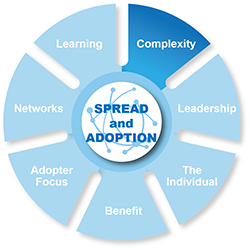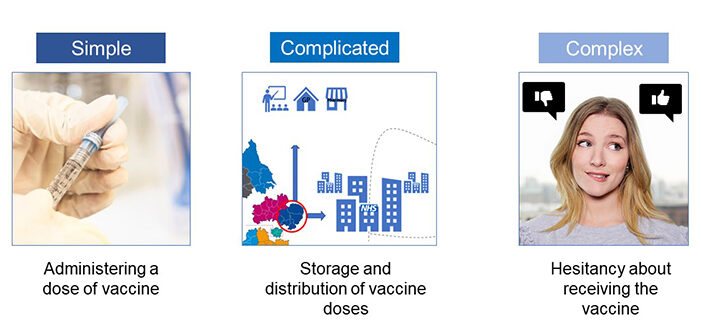Complexity
Content
- Spread and adoption in health and care is a complex activity
- Understanding complexity
- Applying this principle to practice
Spread and adoption in health and care is a complex activity
 The NHS and social care is a complex adaptive system. This means high levels of interdependence and connectivity, competing and changing demands, unpredictability, uncertainty, myriad relationships – as well as the need to work with emergence. Periods of very rapid change can occur but with constant often competing pressures the system, being a complex adaptive system, tends to inertia.
The NHS and social care is a complex adaptive system. This means high levels of interdependence and connectivity, competing and changing demands, unpredictability, uncertainty, myriad relationships – as well as the need to work with emergence. Periods of very rapid change can occur but with constant often competing pressures the system, being a complex adaptive system, tends to inertia.
Spread and adoption in health and care is an increasingly complex activity. Complexity can exist in the innovation, the context, and the approach taken to spread and adoption. Use this resource to help you match the complexity of your spread approach the with complexity of the individual situation.
Spreading an innovation may include aspects that are simple, complicated, and complex. It is important to know the difference.
There are three elements which interact and evolve over time, these are the innovation, the context and the spread and adoption approach taken
Work with the many polarities that impact on the spread and adoption of innovations such as the need to deliver business as usual alongside the need to innovate and improve.
Understand what may slow progress, or even prevent it, within the system (including on infrastructure and resource), and how this may impact on spreading and adopting the innovation
Aim to reduce complexity and then work with it giving attention to socio-political [soft] complexity, through relational approaches, in addition to structural [hard] complexity
Plan to match the complexity of the approach to spread with the complexity of the situation while reflecting the existing inter-dependencies and considering the innovation, context and people who need to be involved.
Increasing complexity produces a greater number of boundaries to be bridged in order to connect and collaborate. Create an adaptive space to enable connections and relationship development, emergence, adaptation, flow of information and for managing the tension between an innovation and the operational system.
Think about the whole system rather than one or some of the many inter-dependent components each with their competing demands and incentives.
More details on Complexity can be found in Complexity further resources.
Understanding complexity
It is important to understand if you are working in a complex situation so you can match your approach to increase the likelihood of success.
Complex – a complex situation is when you can’t predict with certainty the result of actions, there is no cause and effect, the same actions may produce a different effect each time. Complexity is characterised by unpredictability and interconnectivity, the need for flexibility and adaptation and is underpinned by relationships. The result for leaders and staff is the need to be able to work with constant change and emergence and the challenges such a system produces.
A complex situation is not a higher order level of a complicated one but a very different situation. A workplace example is working with many people and organisations crossing organisational and professional boundaries on issues that keep changing. At home an example is raising a child.
Complicated – a complicated situation requires experience and may involve many people and steps but there is predictability and certainty that if the steps are followed the desired result will be achieved. There is a cause and effect relationship. The actions can be repeated at another time with success.
A workplace example is a new item directly replacing an old item used by a specific number of people for a specific reason. Sending a rocket to the moon is an example of a complicated task.
In considering complexity and your spread and adoption plans you need to consider the three aspects of: context, innovation and approach.
Context – the context may be independent and bounded and within your direct influence or may be part of a wider complex system inter-dependent on other parts of the system so not within your direct influence.
Innovation – may be simple or may have multiple components with relational elements which may not be well understood or described and may change with local adaptation and over time. The more complex an innovation the greater the spread and adoption challenge. The innovation may be simple but putting it into practice may be complex e.g. PReCePT.
Spread and adoption approach – there are many available options, the approach taken needs to match the innovation and context especially regarding complexity. See spread in further resources for more information.
Applying this principle to practice
Consider these questions which will be of varying relevance depending on your context:
- How clear are your team and you about the difference between complex, complicated and simple?
- Where does complexity exist in the three aspects of: the innovation, the options for how to spread and adopt the innovation and your context? Is it socio-political [soft] complexity or structural [hard] complexity?
- What are the implications of this complexity and how can you reduce it?
- What are the existing inter-dependencies? How might they change?
- What are the polarities you need to work with?
- What disruption will be caused? What will be the impact and what do you need to do to mitigate this?
- How does your approach to spread and adoption match your context re: complexity and reflect your system?
- How clear are your team and you about when to create an adaptive space?
- Who needs to be included in your adaptive space[s]?
You may find the following helpful, also see practical tools and methods, further resources and systems convening:
- Understanding Complexity
- To help inform your thinking and planning [Complexity models in [HL] complexity further info page]
- Polarity mapping
- Adaptive spaces
